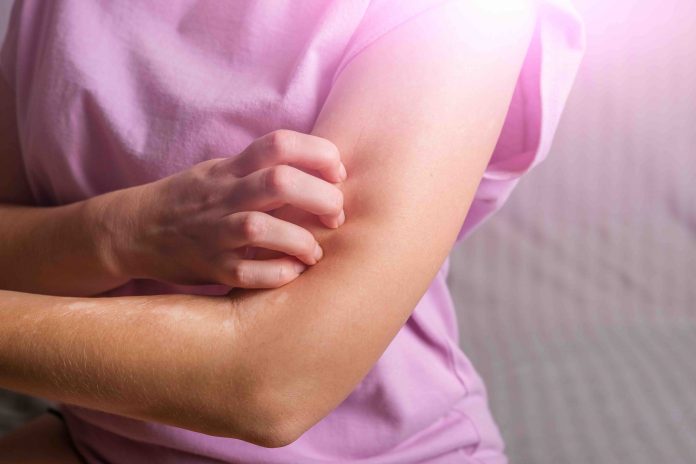Hives can be irritating, uncomfortable and itchy. According to The Australasian Society of Clinical Immunology and Allergy (ASCI), up to 20 per cent of people will experience hives in their life.
Dr Katherine Armour, dermatologist and fellow of the Australasian College of Dermatologists, says the condition can have a huge impact on quality of life, including effects on sleep, and it’s important that people get active treatment.
Symptoms
Hives can look like mosquito bites: small to large, pink or red, itchy rashes and raised red lumps (wheals).
These swellings can disappear within minutes or last for hours, but they may also come and go for days or weeks at a time or even longer.
When hives cause deeper swellings in the skin and mucosa, this is called angioedema, which most often affects the face and lips. However, this is not dangerous.
Should there be, in addition to hives, symptoms of high fever, bruising, bleeding into the skin, purple lumps that last for several days, or sore joints, an urgent visit to the doctor would be necessary.
Causes
In most cases, hives aren’t due to a serious underlying disease.
Underneath the lining of the skin and some of the body’s organs, mast cells contain chemicals including histamine, which, when released into the skin, causes local itching, irritation, redness and swelling.
Hives is not due to an allergy, either, although it can be triggered by a variety of factors, including allergic reactions, which, when related to food, medicines or insect stings, can appear like hives symptoms.
Other causes can include contact allergy from plants or animals, strong cold or heat, and rubbing or scratching of the skin (dermatographism). Stress, alcohol, spicy food, coffee or sweating from exercise may also trigger symptoms.
In many cases, it can be hard to determine the clear cause of hives. For children, the most common cause is often a virus infection.
Allergic causes
According to ASCI, hives may be suspected as being due to an allergic cause if episodes are rare, short-lived and occur under specific circumstances. This could be, for example, when it occurs only when exercising, within two hours of a meal, or if there are other symptoms present, such as stomach pain, vomiting, breathing difficulties or dizziness.
ASCI also states that when there are symptoms of breathing difficulty, swelling of the tongue or throat, or low blood pressure, anaphylaxis should be suspected. Urgent administration of adrenaline and medical assessment are required in this case.
Treatment
Most cases of hives don’t need treatment and will often be over within a couple of weeks. Medications such as non-drowsy antihistamines are commonly used to help reduce the severity of the itch.
“If a patient’s hives aren’t controlled on one or two non-sedating antihistamines a day, we would recommend up-dosing to four a day,” Dr Armour said. “This dosing is based on trials and has well-established safety in children and adults.”
Possible triggering factors to avoid include excessive heat, spicy foods or alcohol. Aspirin, NSAIDs and stress can potentially worsen symptoms.
Specific diets don’t seem to play a major role in the management of hives.
Ongoing hives – chronic urticaria
When hives occur most days for more than six weeks, this is known as chronic urticaria, which is rarely due to an allergy, except for when it may be a medication allergy.
Most sufferers can manage with non-sedating antihistamines. However, Dr Amour says that if the condition isn’t controlled with four antihistamines a day, a referral can be made to either an immunologist or a dermatologist.
If the chronic urticaria is severe, this may require a trial of medicines that reduce inflammation.
“If the hives are of a sufficient severity after that trial, we can apply for a prescription from the PBS for patients of a newer injection therapy called Xolair [omalizumab],” Dr Amour said. “It’s a treatment that has really transformed the control of chronic hives, and we’re one of only two medical groups that can prescribe it.”
Pharmacist’s role
Dr Armour says non-sedative antihistamines in doses of up to four a day can control hives in most people.
“It’s a much safer treatment than long-term steroid medications or sedative antihistamines, which can have very bad and long-lasting side effects,” she said.
“Pharmacists can also provide advice, such as suggesting patients take one or two antihistamines an hour before they go to bed because symptoms tend to flare up at night.”
References:
Written by Tracey Cheung.
This feature was originally published in the August issue of Retail Pharmacy magazine.








